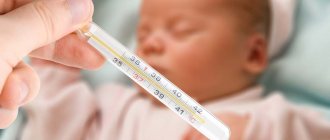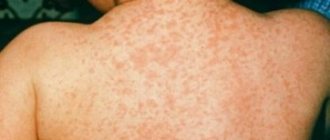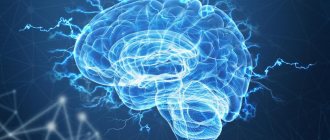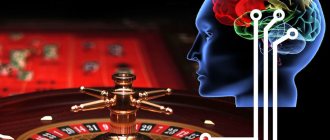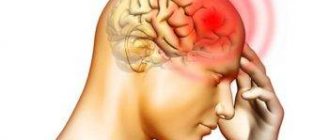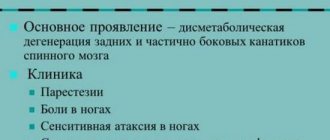Inflammation often occurs as a result of an infection that has entered the body. It can be localized in any tissue depending on the cause of its appearance, and the most dangerous is meningitis. It is characterized by the development of an inflammatory process in the membranes of both the spinal cord and the brain. The disease can occur independently or as a result of another pathological process. The most dangerous consequences occur with reactive meningitis.
To date, this form of the disease has not been studied, there is only general information that allows it to be diagnosed. It is known that the transience of this type of disease is much higher than that of simple meningitis. That is why it is necessary to detect this pathological process in time and begin a course of therapy, otherwise the patient will face a coma or death.
There are different types of meningitis
A doctor looks at a tomogram of the brain.
Reactive meningitis is one of the types of meningitis. Clinicians and WHO offer the following classification of meningitis:
- By type of pathogen: Bacterial (meningococcal, tuberculosis, staphylococcal, pneumococcal)
- Caused by fungi (candida)
- Protozoans
- Viral (Coxsackie and ECHO enteroviruses, mumps)
- Primary – independent inflammation of the meninges (neutropic agents aimed specifically at damaging the nervous system)
- Airborne
- Serous
- Fulminant form (reactive meningitis)
- Lightweight
Meningitis caused by Haemophilus influenzae
Meningitis caused by Haemophilus influenzae is scientifically called HIB meningitis. This form of the disease is the third most common - it accounts for 5-25% of all cases. Among preschool children, HIB meningitis is in second place in the frequency of diagnosis (up to 50% of cases).
Clinically, the disease can occur in different ways: both acute and gradual onset of the disease are typical. The first symptoms are fever, headaches, catarrhal symptoms; meningeal and neurological symptoms appear 4-5 days from the onset of the disease. Small children experience frequent regurgitation, prolonged crying, and bulging of the large and small fontanel.
This is what Haemophilus influenzae looks like
The disease is difficult to diagnose when taking antibiotics in doses insufficient to eliminate the pathogen, since the clinical manifestations in this case are erased, the temperature does not rise to high numbers. In such a situation, the risk of serious complications increases - the process spreads to the substance and ventricles of the brain, and the patient’s condition sharply worsens.
In general, HIB infection is milder than others - meningeal symptoms and fever are moderate, pain is milder.
Currently, mandatory vaccination against pneumococcal infection has been introduced into the vaccination calendar. Before the introduction of routine vaccination against HIB infection, approximately 370,000 cases of pneumococcal meningitis were reported worldwide, with approximately 100,000 cases resulting in death. Currently, the mortality rate for this form of meningitis is about 5% in developed countries and about 30% in developing countries. There are often cases of unfavorable outcome due to persistence of neurological symptoms.
What happens to the body “inside”?
Bacteria enter the human body and cause destruction.
As can be seen from the classification, an infectious pathogen can enter the body through the mucous membrane of the pulmonary system (bronchi, nasopharynx) and gastrointestinal tract. The microorganism then spreads through the lymphogenous or hematogenous route, entering the meninges. Locally, after invasion by an infectious agent, swelling and inflammation of the meninges are observed almost immediately, the secretion of cerebrospinal fluid increases and its outflow is disrupted, which leads to hydrocephalic hypertension, irritation of the cranial nerves and meninges.
If the infectious agent is a bacterium, purulent infiltration of the meninges occurs, with an accumulation of lymphocytes and plasma cells. As a result, specific inflammatory mediators (prostaglandins, enkephalins, leukotrienes) are released, which contribute to the dilation of the vessels of the membranes and the accumulation of pus along the deep veins of the brain. The white matter of the brain becomes swollen and filled with blood. The subarachnoid space is filled with purulent-liquid contents, which spread throughout the brain and flow into its grooves.
Threat to life
Reactive meningitis is one of the most dangerous forms of the disease. Due to the rapid development of symptoms, doctors do not always have time to make a diagnosis and prescribe treatment.
In 10-20% of cases, the pathology leads to death. The causes of death were disseminated intravascular coagulation syndrome, infectious-toxic shock, cerebral edema, respiratory arrest.
Inflammation of the meninges can also have long-term consequences.
The main ones:
- paralysis;
- deafness;
- developmental delay in children;
- epilepsy;
- hydrocephalus and so on.
What happens to the body “outside”?
The girl has a high temperature as a result of infection.
The clinical picture of reactive meningitis and its symptoms consist of the following components:
- Infectious symptoms in reactive meningitis
arise due to intoxication of the body with waste products of the infectious agent.
These include chills; fever(t>37'C); muscle pain; tachycardia and tachypnea (increased heart rate and breathing); loss of appetite; changes in the skin - a grayish or pale tint of the skin; with the generalization of the process and with the transition to a state of sepsis, skin rashes in the form of vesicles and papules are possible; lethargy or restlessness; changes in blood composition - increased levels of leukocytes and ESR. With reactive meningitis, the main symptoms
in the first hours of the development of the disease may be impaired consciousness and convulsive attacks; mortality in their presence increases significantly. - General cerebral symptoms: Represented by dizziness, headache, nausea, vomiting. Headache occurs as a result of damage to parts of the sympathetic nervous system and irritation of the receptors of the meninges and cerebral vessels by the inflammatory process, the action of pathogen toxins and the mechanical action of accumulated cerebrospinal fluid. The headache is characterized as sharp, intense, bursting. The intensity of the headache increases when exposed to light, noise, and tactile stimuli. Nausea and vomiting of central origin (associated with irritation of the vomiting centers of the n.vagus and reticular formation), are not associated with food intake and do not bring relief. Psychomotor agitation or retardation may occur.
- Meningeal symptoms
Reactive meningitis causes a violation of the tone of the muscles of the neck, which is manifested by an increase in muscle resistance when bending the head to the chest - stiff neck. In severe cases of meningitis, the following is detected:
- Kernig's sign - a leg bent at the knee and hip joint cannot be straightened.
- The upper Brudzincki sign is when the neck flexes and the legs bend at the knee joint.
- The average Brudzinski symptom is bending of the legs when pressing on the symphysis pubis.
- The lower Brudzinski sign is flexion of the leg on the opposite side.
- Bekhterev's symptom is a pronounced pain syndrome when tapping on the zygomatic arch.
- “Spotting dog” pose – the head is extended as far as possible and the legs are bent towards the stomach.
- Symptoms of cerebrospinal fluid - increased pressure, cerebrospinal fluid flows out in a stream. Cloudy liquor is purulent meningitis, clear liquor is serous. Increased protein. Decrease in glucose levels in the cerebrospinal fluid.
The doctor diagnoses meningitis.
Reactive meningitis is diagnosed based on the patient’s complaints, his medical history, the above symptoms and laboratory and instrumental data. Increasing symptoms and rapidly progressive deterioration of the patient’s condition can be attributed to reactive meningitis. The main triad for diagnosis is:
- Specific symptoms of meningitis (meningeal)
- Data for the presence of an infectious process
- Cerebrospinal fluid changes
Additional studies that indirectly indicate ongoing reactive meningitis include:
- X-ray of the skull
- Bacterioscopy with isolation of the pathogen on nutrient media
- MRI and CT
- Fundus examination (to detect intracranial hypertension)
Treatment of meningitis
Treatment depends on the type of pathogen that caused the meningitis.
- In case of bacterial meningitis, the patient must be isolated and given antibiotics: drugs of the penicillin group with drugs that have a bactericidal effect - cephalosporins, gentamicin. For viral and fungal infections - antiviral (acyclovir) and antifungal (ketoconazole, flucanozole)
- In case of severe intoxication with loss of fluid and electrolytes, detoxification and restorative therapy should be carried out - intravenous administration of Ringer's solution, 0.9% NaCl, with forced diuresis - mannitol, furosemide.
- If there are seizures, use diazepam.
Course and prognosis of meningitis
Mortality with reactive meningitis is a fairly high percentage. This is due to the fact that the immune response of a weakened body is not able to cope with the increasing number of pathogenic microbes, their generalization and cytopathic effect. In some cases, there is a decrease in sodium ions in the plasma, which can result in fatal convulsions. Sometimes septic shock is observed - tachycardia, tachypnea, hyperthermia, increased leukocytosis. Possible bleeding disorders, deafness and blindness.
Meningitis is an inflammation of the lining of the brain and spinal cord. The process is triggered by an infection, the causative agent of which can be various pathogenic bacteria. These include meningococcus, Pseudomonas aeruginosa, staphylococcus and others. They enter the body through airborne droplets, through consumption of contaminated food, and also through household means, for example, through shared objects or when visiting public places.
Reactive meningitis, the symptoms of which imply fulminant spread and course of the disease, requires special attention. To understand how to prevent and stop a deadly disease, it is important to know the causes of its occurrence, as well as the main symptoms and methods of treatment.
The most common causative agent of meningitis is meningococcal bacillus, which is transmitted by airborne droplets. You can catch the infection anywhere: in a hospital or clinic, on public transport, in a store, and so on. Infection of children usually occurs during epidemics in kindergartens, schools and other educational institutions.
In addition, other types of bacteria can also infect the membranes of the brain; this could be staphylococcus or an enterovirus infection. The following diseases also act as provocateurs of the disease:
- mumps;
- rubella;
- measles;
- otitis;
- sinusitis;
- purulent lesions and abscesses;
- furunculosis.
Often, reactive meningitis can be caused by injuries to the skull and spine. The risk group includes children with weakened immune systems and adults with established or latent immunodeficiency.
What is reactive meningitis, what are its symptoms and can it be cured?
Meningitis is an inflammatory process of the membranes of the brain or spinal cord. This disease is serious and requires immediate medical attention.
One of its most severe forms is reactive meningitis. In this article we will look at the causes and risk factors. We will also pay attention to diagnostic methods and treatment of this disease.
What it is?
The very concept of “reactive” means that the disease is a rapidly developing inflammatory process. That is, with reactive meningitis, a person can die a few hours after infection.
Causes and risk factors
Main causes of reactive meningitis:
- Drug-induced meningitis is aseptic; occurs when nonsteroidal anti-inflammatory drugs, antibiotics, anesthetics, and chemotherapy drugs are introduced into the spinal canal as a result of an allergic reaction-like effect on the membranes of the brain.
- Bacterial or viral process - this occurs against the background of toxoplasmosis, brucellosis, tuberculosis, chickenpox, mumps, polio, HIV, enterovirus infection, etc.
- A reaction to vaccination is inflammation of the meninges after vaccinations against measles, polio, whooping cough, and rabies.
- Tumors of the central nervous system - meningeal leukemia, craniopharygiomas, brain tumors, multiple sclerosis.
- Ischemic foci in extensive strokes.
- Subarachnoid hemorrhages, brain abscesses.
- Hypoxia during childbirth, intracranial hemorrhages in premature newborns.
- Presence of traumatic brain injuries, back injuries.
- Bacterial infections: meningococcal, streptococcal, pneumococcal and others.
When diseases such as otitis media, pneumonia, sinusitis, furunculosis, and sinusitis develop in the body, the infection penetrates into the membranes of the brain with the blood flow from the inflamed foci. This is typical for pneumococci and streptococci.
Meningococcal infection is the most dangerous, capable of causing both isolated diseases and outbreaks of epidemics. Occurs most often.
It is spread by airborne droplets, and you can become infected in crowded places:
- clinics;
- public transport;
- schools;
- kindergartens;
- shops, etc.
Incubation period
The time it takes for the disease to develop in the body depends on many factors. The danger of reactive meningitis is that it often occurs against the background of another disease. It is not always possible to immediately distinguish the signs of incipient inflammation of the membranes. But this form of the disease develops very quickly.
The incubation period can range from several hours to two days. It is important to recognize the symptoms in time; delay can have serious consequences for the health and life of the patient.
Symptoms and signs of reactive meningitis
- High temperature, which rises sharply to 40 degrees at the onset of the disease. The antipyretic reduces it for several hours, and after a second increase it no longer has an effect.
- Headaches without a clear epicenter, which are aggravated by movements, sounds, and bright light.
- Repeated vomiting not associated with meals.
- Muscle pain, convulsions are possible in children.
- Excitement, anxiety, which are replaced by confusion, coma.
- Shortness of breath, increased intracranial pressure, changes in pulse.
- The skin becomes gray and cold, especially the hands and feet. Meningococcal infection causes a rash to appear all over the body.
- Meningeal signs - stiffness of the head and neck.
- In children of the first year of life, the fontanel on the head swells.
Diagnostic methods
If reactive meningitis is suspected, the patient is immediately hospitalized in the intensive care unit or intensive care unit. An accurate diagnosis is made based on the following criteria:
specific symptoms – Brudzinski’s symptoms, Kernig’s symptoms, fundus examination;
- signs indicating infection - results of a general blood and urine test, biochemical blood test;
- hardware examination - skull radiography, EEG, CT and MRI;
- changes in cerebrospinal fluid - lumbar puncture is used to collect cerebrospinal fluid for analysis and bacteriological culture.
Treatment
The course of treatment begins immediately with broad-spectrum antibiotics. Drugs from the penicillin, cephalosporin, and macrolide groups are prescribed. The period of admission is at least 10 days. In addition, antispasmodics and muscle relaxants are prescribed to relieve cramps and muscle spasms - Seduxen, Domosedan and others.
To improve the functioning of the adrenal glands, the patient receives glucocorticoids, and to prevent cerebral edema - Furosemide. If there is already swelling, Sorbilact is prescribed.
Complex therapy is required, consisting of intravenous administration of saline solutions, antipyretics, analgesics, and plasma substitutes. In the first hours, the patient receives all medications using droppers to avoid toxic shock and make treatment more effective.
In cases where the patient is conscious, in addition to taking medications, he is advised to drink plenty of fluids, strict bed rest, and a salt-free diet.
If treatment began in a timely manner and gives a positive result from the first days, then hospitalization will last 7-10 days. If complications occur, the treatment period will last up to several months .
Rehabilitation
- A person who has had reactive meningitis must be registered with a neurologist and regularly examined by him.
- The recovery period after an illness ranges from 6 to 12 months.
- After hospitalization, as soon as the patient’s condition improves, kinesitherapy begins in the form of active and passive exercises and massage.
- To recover after discharge from the hospital, you need to follow a work and rest schedule, spend a lot of time in the fresh air, introduce a restorative daily routine, and lengthen your sleep.
- It is necessary to free the patient from any additional physical activity, watching TV, or visiting crowded places.
Patients who have suffered a reactive form of the disease and who experience disorders in the emotional and mental sphere may be prescribed:
tincture of valerian, hawthorn;
- tranquilizers: sibazon, phenazepam, trioxazine;
- phenibut;
- neurometabolic drugs - piracetam or glycine - to activate brain activity.
All medications are prescribed in courses over several weeks or months. Exercise therapy, massage, physiotherapeutic procedures, and vitamin therapy are also prescribed.
If there are complications, rehabilitation takes place with the involvement of various specialists: neurologists, speech therapists, orthopedists, psychologists. In addition, for those who have had reactive meningitis, sanatorium treatment is indicated.
Consequences and complications
Children and the elderly are primarily at risk for inflammation of the membranes of the brain. Most often, the disease leaves consequences in the form of various complications.
The most likely of them:
- DIC syndrome – formation of blood clots in blood vessels;
- hyponatremia – decreased amount of sodium in the blood;
- delayed neuropsychic development in children;
- paralysis;
- septic shock;
- deafness;
- blindness.
Prevention of meningitis
In order to prevent the disease from reactive meningitis, it is necessary, first of all, timely vaccination and adherence to personal hygiene rules when visiting crowded places. In addition, take vitamins on time to support immunity.
Signs of pathology
This life-threatening disease, like other disorders, has its own characteristic symptoms. For the reactive type of disease, the distinctive feature remains the speed of development of symptoms.
The first clinical signs include:
- clouding of consciousness;
- increased body temperature;
- drowsiness;
- fatigue;
- fever;
- muscle weakness;
- urge to vomit and nausea;
- severe headaches radiating to the back and cervical spine;
- increased sensitivity to light;
- heart rhythm disturbance;
- shortness of breath;
- paresis of limbs;
- hearing and visual impairment;
- skin manifestations.
For infants, a symptom of meningitis is also swelling and tension in the area of the large fontanel.
Headaches that occur when the membranes of the brain are damaged do not go away when taking medications. Posture, which is also a kind of sign of meningitis, helps relieve pain. If you feel better with your head thrown back and your knees bent and pressed to your stomach, you can assume that the person has infectious reactive meningitis.
Diagnosis and treatment
The rapid appearance of symptoms is a cause for concern and immediate consultation with a doctor. Rash, fever and headaches give reason to suspect a meningococcal infection in a patient. Only a specialist can make an accurate diagnosis and identify the pathogen after conducting the necessary research and laboratory tests.
The cerebrospinal fluid allows you to find out which infection is the causative agent. It is collected using a lumbar puncture. A general blood test is also quite informative, but only helps determine the presence of an inflammatory process. In meningitis, leukocyte counts and erythrocyte sedimentation rate are elevated. Reactive meningitis causes changes in the quality characteristics of urine. Traces of protein and blood elements can be found in it.
Once the diagnosis is confirmed, whether in a child or an adult, hospitalization and intensive care are required.
Treatment involves the patient being in a hospital setting. He is given intravenous sodium salt solutions to prevent dehydration, as well as plasma expanders to reduce bacterial activity. Reactive meningitis is often accompanied by acute adrenal insufficiency. In such cases, corticosteroids are prescribed. If convulsions and muscle spasms are observed among the symptoms, antispasmodics and muscle relaxants are included in the treatment regimen.
To suppress the activity of pathogenic bacteria, antibacterial therapy is carried out. Drugs active against infection are administered strictly on an hourly basis in doses prescribed by the doctor. For meningitis, the penicillin group is most often used, as well as cephalosporins and macrolides.
Since the symptoms increase quite rapidly and the patient’s condition worsens, medications are administered intravenously, and only when they improve they switch to medications in tablets. To prevent cerebral edema, diuretics are prescribed (most often Furosemide). If symptoms are already obvious, Sorbilact is administered as part of infusion therapy.
The basis for preventing meningitis is vaccination. Of course, it cannot completely guarantee safety, but it reduces the risk of infection. During epidemics, it is recommended to refrain from visiting crowded places, and also adhere to a number of simple rules:
- observe the rules of personal hygiene;
- if you suspect infection, immediately contact a medical facility;
- when leaving your usual area, study the epidemiological situation;
- avoid contact with carriers of infection.
Since household transmission of pathogenic bacteria is quite common, it is recommended to avoid sharing personal hygiene items with other people to avoid getting sick.
Personal experience: I almost died from meningitis
On the fifth day she said: “Bye, mom, it seems I’m leaving.”
Panic over meningitis in Kazakhstan is gaining momentum. To figure out whether it is justified, in the previous article we learned from family doctor Dmitry Kireev about the consequences of the disease and methods of protection. And now we talked to a girl who had meningitis as a child and remained alive.
About the development of the disease
I got meningitis at age 11. Back in 2001, people did not understand what it was. Some Soviet horror stories told about meningitis - that’s where all the knowledge ended.
She became infected from a sick kitten that she picked up on the street. Doctors later diagnosed me with listeria meningitis, a type that can often be caught from infected animals.
At first, the disease developed like a cold: my throat was blocked and I felt some kind of malaise. I remember well that my mother and I were at the market at the time - I suddenly felt sick. Mom thought I had a cold. They called an ambulance: they confirmed that I just had a cold - nothing to worry about. I'm sure this doctor had never even heard of meningitis.
A little later, I developed a high fever and my whole body began to ache. I felt terrible, but could not explain my condition. The symptoms were like a sore throat - a sore throat, a headache. On the second day I broke out in a rash like rubella. The doctor was called again. He said: “The child has a sore throat with rubella, get treatment, everything is fine with you.”
It’s just that your daughter is spoiled, that’s why she behaves this way. Raise her normally
On the third day it got worse. There was a ringing in my head, even if I just opened my eyes. I have never been in so much pain in my life. I was always a patient child, but then I just screamed: “Mom, it hurts, mom, I have a headache.” When we called the doctor for the third time, they told us: “Your daughter is just spoiled, that’s why she behaves this way. Raise her normally." On the fourth day my legs started to give out. My parents forced me to go to the toilet because I could no longer get up.
On the fifth day I said: “Bye, mom, I think I’m leaving.” She got scared and called an ambulance again. This time, a medical student came with the team, when she looked at me, she immediately said that it was meningitis.
They took me to the infectious diseases hospital. There were no rooms due to the epidemic; they were put in the corridor. I remember well that it was there that the body began to die. There were no thoughts, I just felt that this was the end. A passing doctor noticed my condition and immediately took me to the intensive care unit and pumped me out. I was literally torn from the other world. It seemed that I passed out for five minutes, but it turns out that I didn’t come to my senses for five days.
About treatment
In the hospital, they take a puncture from you - a cerebrospinal fluid analysis. The procedure is very unpleasant - they give you an injection in the spine: one awkward movement and you can be disabled. I don’t know how it is now, but then there was such technology.
She was in a regular ward; it was very scary and lonely. In the first two weeks of treatment I felt as bad as during the illness. Every morning, lunch and evening I was given five injections, given IVs, and given a bunch of medications. But still, I only have good memories of the hospital: the doctors were very attentive and kind.
Immediately after me, my sister fell ill. Mom, taught by experience, demanded that the youngest be taken to the hospital. The second puncture confirmed the presence of meningitis.
On the fifth day I said: “Bye, mom, I think I’m leaving.”
About the consequences
The consequences of meningitis can be dire: some people become deaf or blind, and their mental abilities decrease. My vision has decreased by four diopters, plus my coordination has been impaired - I still can’t ride a bike.
Until I was 18 years old, I was registered with a neurologist, endocrinologist, and often went to preventive clinics. There was a release from physical education, I quickly got tired. After my illness, I noticed that I was no longer able to grasp some abstract things. Abstraction for me is incomprehensible scribbles.
About consequences and panic
I can't blame my parents - they just didn't know what to do. At that time, the news did not broadcast any information, and there was no Internet. Everyone believed that meningitis was some kind of terrible disease, after which a person becomes mentally retarded.
When I returned to school, everyone avoided me. It turns out that the school was quarantined. Classmates asked: “How do you talk? Did you go crazy there? Your brain is damaged." It is clear that they were simply repeating the words of their parents.
Now everything is different: people send useful articles about symptoms and prevention, the media publishes materials. Everyone knows everything about meningitis, even a child recognizes the first signs. I hope that growing awareness will finally heal society and survivors will no longer have nightmares.
It seems to me that in order to avoid getting meningitis, you need to know basic things. The disease is dangerous in the wet period - in spring or autumn. At this time, parents need to be careful: do not let their children play with street animals, and pay close attention to the child’s condition. If you complain of feeling unwell, immediately call a doctor and demand a responsible examination.
Forecast
Reactive meningitis without treatment is fatal. Only a patient who seeks help on time can count on a favorable result. The prognosis for recovery largely depends on the general condition of the body, the presence of concomitant diseases and the age of the patient.
It is easier for middle-aged people to cope with the disease than for the elderly and children, who have reduced body defenses.
In infants, the disease develops so rapidly that therapy in most cases does not guarantee full recovery. If the child can be saved, severe complications such as blindness, paralysis and developmental delays often occur.
Only timely access to a medical facility increases the chances of recovery and helps prevent premature death from cerebral edema.
Meningitis is an acute infectious disease that leads to inflammation of the membranes of the spinal cord and brain. The infection can be caused by fungi, viruses and various bacteria, for example: Haemophilus influenzae, enteroviruses, meningococcal infection, tuberculosis bacilli. Signs of meningitis can appear at any age, but, as a rule, people with weakened immune systems, premature babies, patients with head injuries, back injuries and central nervous system lesions become ill.
With adequate and, most importantly, timely treatment of meningitis, vital organs and systems of a person usually do not suffer. The exception is the so-called reactive meningitis, the consequences of which can be extremely severe. If treatment for meningitis is not started within the first 24 hours after the onset of severe symptoms, the patient may become deaf or blind. The disease often leads to coma and even death. As a rule, meningitis in children and adults forms immunity to the action of pathogens, but there are exceptions. However, cases of recurrent disease are extremely rare. According to experts, the infection occurs again in only 0.1% of people who have recovered from the disease.
What can meningitis be?
The disease can be primary or secondary. The first type of infection is diagnosed if the meninges are immediately affected during infection. Secondary meningitis in adults and children manifests itself against the background of an underlying disease (leptospirosis, otitis media, mumps, etc.), develops slowly, but ultimately also leads to damage to the meninges.
A distinctive feature of both types of infection is the acute nature of the clinical course of the disease. The disease develops over several days and requires immediate treatment to prevent serious complications. An exception to this rule is tuberculous meningitis, which may not manifest itself for several weeks or even months.
Causes of meningitis
The main causative agent of the disease is meningococcal infection. In most cases, it is transmitted by airborne droplets. The source of infection is a sick person, and you can catch the infection anywhere, from public transport to clinics. In children's groups, the pathogen can cause real epidemics of the disease. We also note that when a meningococcal infection enters the human body, purulent meningitis usually develops. We will talk about it in more detail in one of the following sections.
The second most common cause of the disease is various viruses. Most often, enterovirus infection leads to damage to the membranes of the brain, however, the disease can also develop in the presence of the herpes virus, measles, mumps or rubella.
Other factors that provoke meningitis in children and adults include:
- boils on the neck or face;
- frontal sinusitis;
- sinusitis;
- acute and chronic otitis media;
- lung abscess;
- osteomyelitis of the skull bones.
Reactive meningitis
Reactive meningitis is one of the most dangerous forms of infection. It is often called fulminant due to its extremely transient clinical picture. If medical assistance was provided too late, the patient falls into a coma and dies from multiple purulent foci in the brain area. If doctors began to treat reactive meningitis within the first 24 hours, the consequences will not be so serious, but they can also threaten a person’s life. Timely diagnosis, which is carried out by taking a lumbar puncture, is of great importance in reactive meningitis.
Page of eternal memory of Anastasia Chervyatsova
This is a page in memory of Anastasia Chervyatsova.
It is prohibited here: writing swear words, writing something bad about Nastyusha, arguing with other visitors to the page, expressing dissatisfaction with the created page, etc. Show in full... Doctors were unable to help due to the rapid development of the disease.
On April 15, 10th grade student Nastya Chervyatsova called the class teacher and warned that she would not come to school - she complained of a rising temperature and a headache. At 16:30 the girl was already taken by ambulance to the infectious diseases hospital. We only managed to do a blood test, and at 19:20 Nastya died. The diagnosis that the doctors made was reactive meningitis.
“This is a terrible, fatal accident, an absurd, cruel coincidence of circumstances,” says Lyudmila Osipova, director of Lyceum No. 49, where Nastya studied. - Sweet, kind girl, beauty, wonderful person. We are all in great pain.
Preventive measures recommended by the SES were carried out, doctors examined classmates. They and their parents were given special leaflets containing a list of preventive measures that need to be taken at home.
The lyceum was unusually quiet yesterday. No noise, no screams, silence. Everyone is shocked by what happened. A page on one of the well-known social networks is filled with words of grief and love from the girl’s friends: “Nastya left so early without seeing this adult life. You are always with us, your love is with us. May you rest in peace."
Meningitis is an infectious disease transmitted by airborne droplets. Infection occurs from already sick people or virus carriers through talking, coughing, sneezing, or kissing. Those at greatest risk are those who have already contracted upper respiratory tract diseases. That is why outbreaks of meningitis are mainly seasonal - winter, spring and autumn months. The disease begins acutely, with a sudden increase in temperature to 38 - 40 C, headaches and photophobia appear.
08/21/1994 - 04/15/2010 On the left is the date of birth, on the right is the date of death, and between them is a line the length of a life (c)
Nastenka, dear, you will forever remain in our hearts! We remember and love you! And we will never forget!
Full name: Chervyatsova Anastasia Igorevna Date of birth: August 21, 1994 Parents: Chervyatsova Olga Viktorovna and Chervyatsov Igor Brothers/sisters: Tanya Avdeeva (cousin), Sonechka (step-in-law), Kirill brother (brother) T.Olya gave birth to him in May 2011, Ignat. Pets: cat Lyuska (ALIVE.) Place of residence: Kaliningrad, Zoological street Height: 162 Occupation: artist Activities: student Class 10″ b "(did not finish) Educational institution: Lyceum No. 49, Art School No. 2 Eye color: blue Hair color: Light brown Date of death: April 15, 2010 Cause of death: Meningococcemia (reactive meningitis)
- All entries
- Community Posts
- Search
Page of eternal memory of Anastasia Chervyatsova post pinned
Page of eternal memory of Anastasia Chervyatsova post pinned
Yulia Pisarenkova post pinned
Yulia Pisarenkova post pinned
Yulia Pisarenkova post pinned
Yulia Pisarenkova post pinned
Anyuta Miley post pinned
Few people know what reactive meningitis is. Meanwhile, this is a very dangerous and terrible disease that requires special treatment.
Reactive meningitis is an acute infectious disease that affects parts of the brain or spinal cord. People of all ages can suffer from this disease. However, reactive meningitis often affects newborn premature babies, people with back injuries, head injuries and damage to the nervous system. Show in full…
Reactive meningitis has one feature - it occurs spontaneously and unexpectedly. In this form, meningitis is severe and transient. Generally speaking, reactive meningitis is one of the most dangerous forms of infection.
A patient with such a diagnosis should receive immediate medical attention, since a large number of purulent foci develop in his brain. As a result, a person may fall into a coma and even die.
Although, if you start treating the disease within the first twenty-four hours, the consequences of reactive meningitis will not be so serious. It is very important to make timely diagnosis of the disease based on analysis of lumbar puncture.
As a rule, the causative agent of this type of meningitis is meningococcal bacillus. The infection is transmitted from the carrier (sick person) by airborne droplets. The source of infection can be present in any place where there is a large crowd of people: public transport, a store or a clinic.
Reactive meningitis can lead to the spread of the epidemic among children attending kindergartens and group activities. In addition to meningococcal bacillus, meningitis can be caused by enterovirus infection and other viruses.
In addition, diseases such as measles, mumps and rubella can provoke the development of this serious disease. At risk are patients suffering from lung abscess, sinusitis, as well as people with boils on the face and neck.
Symptoms of reactive meningitis:
High temperature (up to forty degrees); Prolonged fever for several days; Attacks of vomiting; Stiff neck; Sharp pain in the throat. Impaired hearing, facial and eye muscles; Partial paralysis. At the initial stage, reactive meningitis is often confused with respiratory diseases, however, unlike them, it is very fleeting. Treatment of meningitis must be carried out immediately in a hospital. The patient is prescribed complex treatment, antibacterial and supportive therapy. Timely diagnosis and properly prescribed treatment make it possible to cope with the disease. Mortality from reactive meningitis accounts for approximately 10% of the total number of cases.
Since it is not always possible to accurately determine the nature of the causative agent of reactive meningitis, all antibacterial therapy is based on the empirical selection of therapeutic drugs. To prevent the spread of viruses and eliminate the possible causative agent of the disease, the patient is prescribed one or another antibiotic. This course of treatment depends on the characteristics of the patient’s disease and his condition.
Unfortunately, with late diagnosis of this type of meningitis, the mortality rate increases significantly. This also happens when children, elderly and weakened people fall ill with reactive meningitis. Anastasia Chervyatsova died with this disease due to late diagnosis. On April 15, 2010, 10th grade student Nastya Chervyatsova called her class teacher and warned that she would not come to school — complained of a rise in temperature and headache. At 16.30 the girl was already taken by ambulance to the infectious diseases hospital. They only managed to do a blood test, and at 19.20 Nastya died.
source
Purulent meningitis in adults and children
Purulent meningitis is characterized by the development of cerebral, general infectious and meningeal syndromes, as well as lesions of the central nervous system and inflammatory processes in the cerebrospinal fluid. In 90% of reported cases, the causative agent of the disease was infection. If a child develops purulent meningitis, the symptoms initially resemble a common cold or flu, but within a few hours patients experience characteristic signs of a meningeal infection:
- very severe headache;
- repeated vomiting;
- confusion;
- the appearance of a rash;
- neck muscle tension
- strabismus;
- pain when trying to pull your head to your chest.
In addition to the above symptoms of meningitis, some other signs are also found in children: drowsiness, cramps, diarrhea, pulsation of the large fontanel.
Treatment of meningitis
Patients with meningitis are subject to immediate hospitalization. Do not try to treat meningitis with folk remedies and do not delay calling an ambulance at all, since jokes with the infection can easily result in disability or death.
Antibiotics are the drugs of choice for treating meningitis. Let us note that in approximately 20% of cases it is not possible to identify the cause of the disease, so hospitals use broad-spectrum antibiotics in order to affect all possible pathogens. The course of antibiotic therapy lasts at least 10 days. This period increases in the presence of purulent foci in the skull area.
Currently, meningitis in adults and children is treated with penicillin, ceftriaxone and cefotaxime. If they do not give the expected effect, then patients are prescribed vancomycin and carbapenems. They have serious side effects and are used only in cases where there is a real risk of life-threatening complications.
If severe meningitis is observed, the patient is prescribed endolumbar administration of antibiotics, in which the drugs enter directly into the spinal canal.
Video from YouTube on the topic of the article:
Reactive meningitis is a deadly disease in which the meninges become inflamed. The threat to life is especially high for children, the elderly and people with a low immune response. The disease is difficult to diagnose due to the rapid progression of the inflammatory focus, which puts a person into a coma within a few hours.
The main reason for the development of pathology is infection. The infectious agent enters the body as follows:
- by airborne droplets, when a person inhales contaminated air while communicating with a carrier;
- by contact, in which pathogens settle on the skin and then penetrate the body;
- through food products containing pathogenic microorganisms.
If a person becomes infected in one of the described ways, primary meningitis is diagnosed. If the disease develops as a result of a complication of sore throat, pneumonia or other infections, then a secondary form of the disease is detected.
The airborne method of spreading infection often leads to epidemiological outbreaks.
When meningeal pathogens enter the body, inflammatory phenomena develop in the meninges. Then the brain swells, leading to disruption of the functioning of cerebral vessels. Due to decreased absorption of spinal fluid, intracranial pressure increases sharply, and hydrocephalus is diagnosed. As a result, the spinal and cranial nerve endings become inflamed.
The development of meningitis is also facilitated by head and back injuries, inflammatory diseases, and the presence of boils on the body.
Causes of infection
The following infections can cause a fulminant type of meningitis:
- Pneumococcal;
- Meningococcal;
- Streptococcal.
In rare cases, pathology is caused by a fungus or even a virus. It is transmitted using the following ways:
- Lymphogenic. The spread of infection occurs through the lymph;
- Contact. Infection occurs due to head trauma;
- Perineural. The infection spreads to the brain tissue due to inflammation of the nerves;
- Airborne. The disease is transmitted through the air, for example, when an infected person coughs near a healthy person;
- Hematogenous. The infection initially enters the blood and then reaches the brain;
- Placental. This route of transmission occurs through the placenta from mother to baby.
There have often been cases when, against the background of a severe head or back injury, a reactive type of meningitis developed. That is why, even with minor injuries in these departments, doctors advise staying in the hospital for some time. The disease can be spread by eating unwashed food or poor hygiene, such as dirty hands. In children, meningitis occurs due to tonsillitis or pneumonia.
When the perineural process begins, when inflammation is transferred to the brain tissue from the affected nerves, the disease progresses very quickly. In such a situation, you need to have time to stop the pathology, focusing on the emerging symptoms.
Symptoms
Reactive meningitis manifests itself abruptly, so at the first suspicious signs you should consult a doctor. Delay can cause irreversible complications and death.
Important! If symptoms rapidly increase, you should call an ambulance.
The main symptom of the disease is a painful headache that increases with physical activity. The patient cannot bend his head towards the chest. Such pain can lead to loss of consciousness. Associated symptoms are hot flashes, fever, chills.
Diagnostic methods
Any of the manifestations of meningitis should make the doctor suspect an infection. It is necessary to urgently hospitalize the patient for emergency diagnostic measures, including:
- lumbar puncture, during which spinal fluid is collected;
- clinical blood test, which determines the concentration of leukocytes and erythrocyte sedimentation rate;
- urine test indicating the presence of protein;
- fundus examination;
- radiography;
- computed tomography.
After instrumental confirmation of the diagnosis, intensive therapy begins.
How is the diagnosis made?
An accurate diagnosis can only be made using a lumbar puncture.
Only this study can distinguish meningitis from other diseases with similar symptoms. But such a study takes time, so blood is urgently taken for general and biochemical analysis. In addition, a fundus examination, EEG, skull radiography, and MRI are performed.
An accurate diagnosis of the patient is made based on three main signs: specific symptoms of meningitis, signs indicating infection of the patient and changes in the cerebrospinal fluid.
Treatment
Reactive meningitis is treated in a medical facility. One of the main means of treatment is antibacterial drugs.
The choice of a specific antibiotic depends on the causative agent of the disease, which is determined after analysis. Typically, maximum doses of macrolides or penicillins are administered intramuscularly. If shock develops, medications are administered intravenously; if the patient’s condition rapidly worsens, medications are administered into the spinal region.
In addition to fighting the causative agent of meningitis, the evacuation of toxins from the body is required. For intoxication purposes, potassium preparations and saline solutions are used. For kidney failure, corticosteroids are used, and for convulsive syndrome, antispasmodics. To prevent cerebral edema, Furosemide is prescribed.
Antipyretic drugs are necessary to reduce the readings on the thermometer. The patient needs to take multivitamin complexes to restore the body's defense response and speed up the healing process.
Reactive or fulminant meningitis
– an inflammatory disease of the membranes of the brain, characterized by the rapid development of symptoms, the serious condition of the patient and a fairly high mortality rate. The most common cause of the development of this form is bacteria - meningococci, streptococci, pneumococci, transmitted by airborne droplets from person to person. Reactive meningitis can be either a primary infection or a secondary one - for example, with cracks and fractures of the skull and cervical vertebrae, the microflora easily penetrates the meninges, multiplies and provokes an inflammatory reaction.
The rapid development of fulminant meningitis often leaves doctors no time for diagnosis, because even an adult in the absence of treatment measures will not live more than 1-2 days, children have even less time.
Symptoms
The course of reactive meningitis is hyperacute, all the symptoms that the infected person experiences are within 24-48 hours, mixing and erasing. As with other forms of inflammation of the meninges, symptoms of damage to the nervous system are of diagnostic importance:
- Exhausting vomiting with attacks of cutting pain in the abdomen;
- Spastic tension in the muscles of the back of the head, neck and calf, causing the patient’s characteristic position - lying on his side, head thrown back, legs bent at the knees and pressed to the stomach;
- Clonic-tonic convulsions, followed by lethargy and apathy;
- Severe headache and muscle pain;
- Increased tactile, auditory and visual sensitivity.
The temperature in patients with reactive meningitis, as a rule, exceeds forty degrees. With rapidly spreading purulent inflammation of the meninges, the cranial and spinal nerves are often affected, which is clinically expressed as unilateral paralysis of the face or limbs.
Reactive meningitis is also characterized by a sharp shift in blood counts, increased vascular permeability - spots of hemorrhages and hemorrhagic diathesis appear on the skin. The breakdown of red blood cells and the release of hemoglobin leads to an increase in the level of hemosiderin in the blood, liver and kidneys - a very characteristic black rash may appear on the skin, and the patient’s urine becomes dark in color.
An integral symptom of fulminant meningitis is disseminated intravascular coagulation (DIC) - blood clotting inside the vessels with the formation of small blood clots that block the blood flow in the capillaries. At the same time, small pockets of infarctions form on the skin, mucous membranes and internal organs; rupture of capillaries can cause hemorrhage in the brain.
Diagnostics
The rapid development of the clinical picture does not allow doctors to conduct a full diagnosis, since there is virtually no time for it. However, using the lumbar puncture method, cerebrospinal fluid is taken for examination, applied to a glass slide, Gram stained and microscopically examined. Detection of coccal forms of bacteria allows an accurate diagnosis to be made.
Changes in the composition of the blood are considered characteristic - increased breakdown of red blood cells with the release of iron, extremely. Due to the rapid development of the disease, the immune system does not have time to react properly and is only rarely detected. In hyperacute meningitis, urine becomes dark in color, and protein and blood elements are found in it.
Treatment
Therapy for reactive meningitis must be immediate and intensive, otherwise death cannot be avoided. Because there is no time to determine the sensitivity of microflora, antibacterial drugs are prescribed empirically, choosing groups that can affect all possible microbes - penicillins, cephalosporins, macrolides.
Antibiotics are administered intramuscularly at the maximum therapeutic dose every three to four hours; the time and dose of each injection are recorded on paper. If treatment is delayed and the patient’s condition is severe, then in addition to the general course, antibiotics are administered into the spinal canal.
If the patient is able to drink, he is prescribed a plentiful drinking regime. Electrolyte solutions and plasma expanders are administered intravenously, while furosemide is prescribed to avoid cerebral edema. To relieve cramps and muscle spasms, antispasmodics and muscle relaxants are prescribed.
Reactive meningitis is an extremely dangerous disease, the prognosis for which in most cases is unfavorable. Only timely and intensive treatment can avoid death; in children and the elderly, the progression is so rapid that medicine is often powerless. To avoid infection with reactive meningitis, it is necessary to avoid contact with possible sources of infection, not to visit places of outbreaks of the disease, and to strictly observe the rules of personal hygiene.

